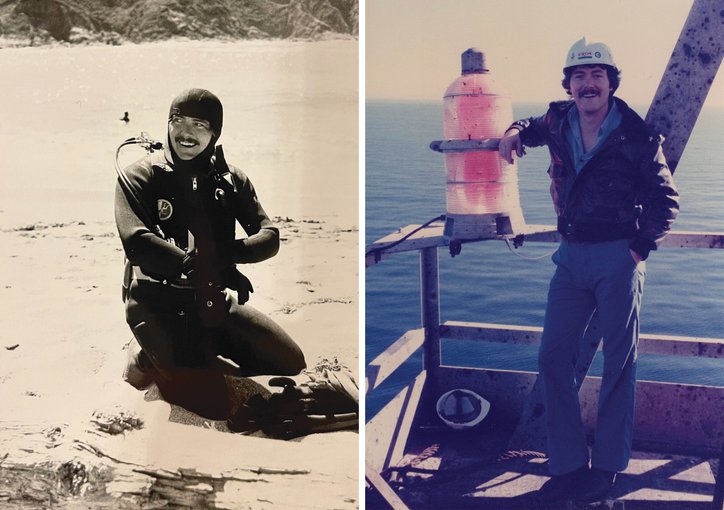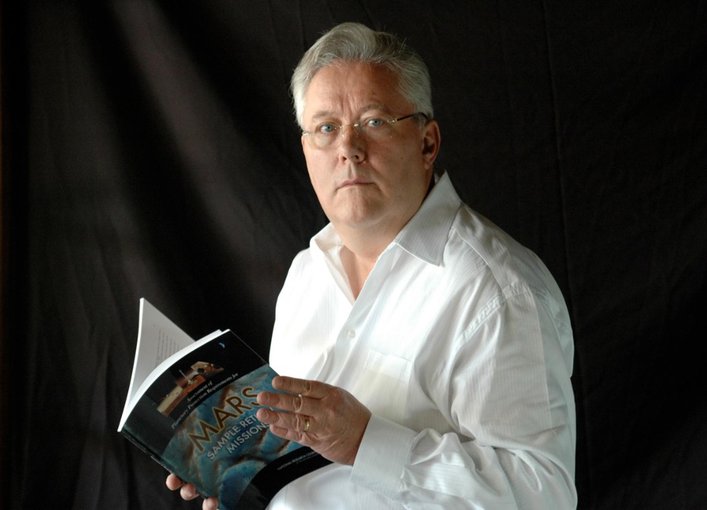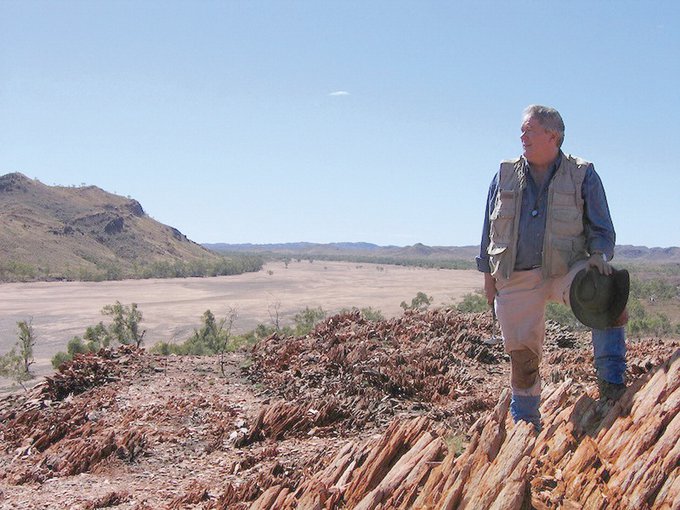
Jack Dwayne Farmer was an exceptional scholar, field geologist, teacher, mentor, and key contributor to NASA’s flight missions and programs. He was also an exemplary friend and advocate for so many people from all walks of life. He will be deeply missed.
Early in his career, Jack was a lecturer and collections curator at University of California (UC), Davis and its Bodega Laboratory, a senior petroleum geologist at Exxon, an adjunct professor at UCLA, and a visiting professor at California State University, Long Beach (Fig. 1). Jack later became a world leader in the burgeoning field of astrobiology (an expansion of NASA’s earlier Exobiology program). His never-ending curiosity about the roles that microbes play in chemical sedimentary systems took him to field sites on nearly every continent. He centered his research on biomineralization processes and the various ways in which life modifies sedimentary fabrics in hydrothermal systems, evaporative lakes, and arid soils. Along with the students and colleagues he mentored, Jack examined the processes that contribute to the capture and preservation of biosignatures over a broad range of environmental conditions, including the influences of biology on diagenesis. His broad range of experiences enabled him to contribute novel insights into the early record of life on Earth and champion an enduring framework to search for a record of past and present life on Mars.

FIG. 1. Jack's early career days. (Left) Preparing for an ocean dive at Bodega Research Laboratory. (Right) On Exxon's offshore platform Harmony.Image credit: Photographers unknown; images provided by M.C. Farmer..
While at NASA’s Ames Research Center in the 1990s, Jack pursued field studies in environments on Earth that resembled those on early Mars. He investigated microbial fossilization and the biosedimentology of extreme environments, microbial processes in early diagenesis, the morphogenesis of modern and ancient microbial stromatolites, and the roles that metazoan grazers play in stromatolite morphogenesis. Jack’s studies of microbial mat ecosystems at Guerrero Negro, Baja California Sur, Mexico, provided an important environmental context for the many biogeochemical investigations conducted later at that site. He studied thermal spring microbial communities and mineral deposits at Yellowstone National Park and other localities in the western United States (Fig. 2) and documented the morphological and geochemical features in the sedimentary facies of acid and alkaline thermal springs. He catalogued an array of features in a Devonian-age thermal spring deposit that corresponded closely to those of modern hot springs, and he outlined in detail a systematic paleontological approach to characterizing ancient thermal spring deposits.

FIG. 2. Jack during his NASA research scientist days in Yellowstone National Park, USA. (Left) Sampling a hot spring in Yellowstone National Park, USA. (Right) Mammoth Hot Springs, Yellowstone (left to right): Baruch Blumberg (NAI Director), Catherine Tsairides (Lockheed-Martin), Linda Young (NPS), Jack Farmer (ASU), Dave Ward (Montana State University), Dave Des Marais (NASA), and Nancy Hinman (University of Montana).Image credit: Image by Michael Milstein (Left), D.J. Des Marais (Right).
Jack also became extensively involved with NASA mission planning during the 1990s. He assumed a key role in planning Mars exploration when it faced daunting challenges and performed landing site studies to support the exploration for martian life (Fig. 3). Importantly, Jack advocated that any search for evidence of past or present life must occur within the context of characterizing past environments, including their climates, sedimentary processes, and potential for preserving a fossil record. He coined the term “exopaleontology” and championed many of the principles that the Mars Exploration Program continues to incorporate to this day.

FIG. 3. Jack with a Mars Planetary Protection document.Image credit: Image by M.C. Farmer.
After joining Arizona State University (ASU) in 1998, Jack continued his research in geobiology and involved his students in projects relevant to the geological and astrobiological exploration of Mars. He investigated the microbial biosedimentology of extreme environments (e.g., hydrothermal, hypersaline, arid, polar, deep sea), early biosphere development, the evolution of Precambrian benthos, and the origins of multicellular life. He contributed to developing scientific instrumentation for flight missions and Mars analog environment studies. One example is a multispectral microscopic imager, which he helped develop and deploy in the field. He received the NASA Group Achievement Award for the In Situ Lunar Surface Operations and in situ Resource Utilization (ILSO/ISRU) Field Test on Mauna Kea, Hawaiʻi.
Jack participated directly in Mars landed missions (Fig. 4). He served as a Long-Term Planning Lead on the MER Science Operations Working Group for the Spirit rover and helped document features formed by an ancient hydrothermal system in the Columbia Hills region of Gusev Crater. He helped interpret the significance of opaline silica observed by Spirit, facilitating one of the first discoveries of an ancient habitable environment on Mars. He also was a member of the CheMin instrument team of the Mars Science Laboratory (Curiosity rover) mission. Identifications of minerals by this X-ray diffraction instrument have characterized past ancient habitable environments within Gale Crater.

FIG. 4. Jack's involvement in NASA missions. (Left) 2002 FIDO rover trials at JPL (left to right): Jack Farmer (ASU), Larry Soderblom (USGS), John Grotzinger (MIT), and Andrew Knoll (Harvard). (Right) Launch of the Curiosity rover, 2011, Kennedy Space Center (left to right): David Blake (NASA, Ames), David Vaniman (Los Alamos National Laboratory), and Jack Farmer (ASU).Image credit: Images by D.J. Des Marais.
In parallel with his research and teaching, Jack provided extensive service to his university, the broader scientific community, and the public. At ASU, he became Director of the ASU Astrobiology Program and Principal Investigator of one of the founding teams in NASA’s Astrobiology Institute (NAI). He was a member of NASA’s Space Science Advisory Committee and a Chair of the Mars Exploration Program Analysis Group (MEPAG), which performs studies and sponsors an active forum with the Mars science community. Jack contributed to the revision of NASA’s 2004 Astrobiology Roadmap and substantially influenced the astrobiology strategy for Mars exploration. He also served as an officer for the Geological Society of America (GSA) and received the GSA Geobiology and Geomicrobiology Division Award for outstanding contributions to the fields of geobiology and geomicrobiology.
Jack was an exemplary instructor and mentor at UC Davis, UCLA, and ASU (Fig. 5). He taught courses in paleontology, sedimentology, oceanography, planetary science, mineralogy, petrology, astrobiology, and physical and historical geology. He innovated several teaching techniques, particularly during the recent pandemic. For example, he created 3-D scans of geologic specimens that were employed extensively during remote instruction. He was beloved by his students. At ASU’s School of Earth and Space Exploration (SESE), he was highly sought out by undergraduates for his generous dedication to answering science questions and for providing professional career advice. He was a highly conscientious and caring graduate student mentor.

FIG. 5. Jack with graduate students Marisol Juarez Rivera, Svetlana Shkolyar, postdoc Charlene Estrada, and undergraduate Nicky Marin.Image credit: Image provided by M.C. Farmer.
Jack was dedicated to informal education. He engaged the public through numerous articles, lectures, and TV and radio interviews. As “Dr. Rock,” he became an institution at SESE’s annual “Earth and Space Exploration Day” (Fig. 6), introducing countless elementary-age children to the wonders of geology. He was an instructor for the Mars Education Program at ASU, particularly in activities that offered science experiences to teachers and students.

FIG. 6. Jack sharing his geological expertise. (Left) “Dr Rock” identifying rocks at SESE's Earth and Space Exploration Day. (Right) Jack leading a field trip at Steamboat Springs, Nevada.Image credit: Image by M.C. Farmer (left), D.J. Des Marais (right).
Jack was particularly active in outreach to Native American communities, being himself of Cherokee and Chickasaw ancestry. He co-founded the Northern California Professional Chapter of the American Indian Science and Engineering Society (AISES, Fig. 7). He participated extensively in several professional Native American organizations, including the Society for Advancement of Chicanos/Hispanics and Native Americans in Science (SACNAS), for which he was honored.

FIG. 7. Jack thriving with his own and his greater family. (Left) Bethany, Jack, and Maria Farmer at the 2021 AISES National Conference. (Center) Jack giving the keynote talk at the 2014 SACNAS National Conference. (Right) Jack being honored for his service with a Pendleton blanket.Image credit: Image by M.C. Farmer (Left, Center), SACNAS (Right).
Jack was an avid guitarist and singer, much to the delight of those fortunate enough to share a campfire with him after a day in the field.
For his career achievements, Jack was elected Fellow of the Geological Society of America. He received the Erasmus S. Haworth Distinguished Alumnus Award for academic achievements in research, teaching, and service given by the Department of Geology, University of Kansas. Chico State awarded him a distinguished alumni award.
Through it all, and perhaps most fundamentally, Jack was a generous and patient teacher. He loved to share his knowledge, especially in the field. He never talked down to anyone, as he was that rare scholar who could meet you where you were, whether novice or peer, wanting nothing more than to enlighten and inspire. It was a key secret to much of his success.
Jack Farmer’s exceptional legacy will endure among his family, friends, colleagues, students, and in various disciplines of science, most importantly the field of astrobiology (Fig. 8). His favorite quote, below, characterizes his wishes for the fields of science that he loved.

FIG. 8. Jack at an outcrop in the Trendall Reserve, Pilbara Craton, Western Australia.Image credit: Image by G. Bruce.
There is grandeur in this view of life, with its several powers, having been originally breathed into a few forms or into one; and that, whilst this planet has gone cycling on according to the fixed law of gravity, from so simple a beginning endless forms most beautiful and most wonderful have been, and are being, evolved. (Charles Darwin, On the Origin of Species)
Written by: David J. Des Marais, Maria C. Farmer, Ariel D. Anbar, Jonathan Zaloumis, Svetlana Shkolyar, Charlene Estrada, and Sherry L. Cady. Re-posted with permission from the journal Astrobiology. DOI: 10.1089/ast.2023.0044

Jack Dwayne Farmer.Image credit: Image by J. Shostak, SETI Institute.
Jack was such a patient and kind person, even when faced with some serious frustration. Once, during our research meeting, a guy off the streets tracked Jack down in his own lab to show him a sample he found. (This was fairly routine, actually!) The guy claimed it was going to revolutionize paleontology in some way and wanted Jack's confirmation that he had found a rare and important fossil. Jack was unimpressed and too busy for these antics. He reached into his pocket, and gave the guy cash to "buy" the sample from him and investigate it further in his lab. This got rid of the guy fairly quickly. Best $20 test of patience ever, Jack!
I first met Jack when I was an engineering masters student and took his Astrobiology course as my science elective. The entire class was amazing, but the highlight was a 3-day field trip to Death Valley, where we got to see first-hand many of the environments we had learned about. As wonderful as Jack was in the classroom, he was clearly in his element while in the field. Shortly after that, I had the opportunity to work with Jack as a colleague on the MER-Spirit rover mission, where I served as a Payload Uplink Lead for the Mini-TES spectrometer during our time investigating the hydrothermal features of Home Plate. When I later decided to switch from engineering to geology and was accepted to the PhD program at ASU, Jack enthusiastically joined my dissertation committee and helped me to develop my first independent research project in Saline Valley, CA. Like so many others, my life was drastically changed for the better by knowing Jack, and I know the lessons he taught me will continue influencing me for the rest of my career and life.
I did my PhD under Jack on Raman spectroscopy for Mars biosignature detection. Appropriately, one of the most memorable things Jack would tell me as I was finishing up my dissertation was, "Focus on your writing like a laser beam!"
This may be a little-known fact, but Jack had a pretty great Elvis singing voice. During field expeditions with students, at camp sites at night around the fire, he could be seen (and heard!) singing the night away on his guitar. He passed on his love of guitar to his daughter, Bethany.

